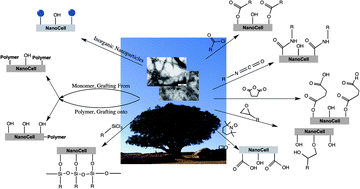Key advances in the chemical modification of nanocelluloses
Abstract
Nanocelluloses, including nanocrystalline cellulose, nanofibrillated cellulose and bacterial cellulose nanofibers, have become fascinating building blocks for the design of new biomaterials. Derived from the must abundant and renewable biopolymer, they are drawing a tremendous level of attention, which certainly will continue to grow in the future driven by the sustainability trend. This growing interest is related to their unsurpassed quintessential physical and chemical properties. Yet, owing to their hydrophilic nature, their utilization is restricted to applications involving hydrophilic or polar media, which limits their exploitation. With the presence of a large number of chemical functionalities within their structure, these building blocks provide a unique platform for significant surface modification through various chemistries. These chemical modifications are prerequisite, sometimes unavoidable, to adapt the interfacial properties of nanocellulose substrates or adjust their hydrophilic–hydrophobic balance. Therefore, various chemistries have been developed aiming to surface-modify these nano-sized substrates in order to confer to them specific properties, extending therefore their use to highly sophisticated applications. This review collocates current knowledge in the research and development of nanocelluloses and emphasizes more particularly on the chemical modification routes developed so far for their functionalization.


 Please wait while we load your content...
Please wait while we load your content...